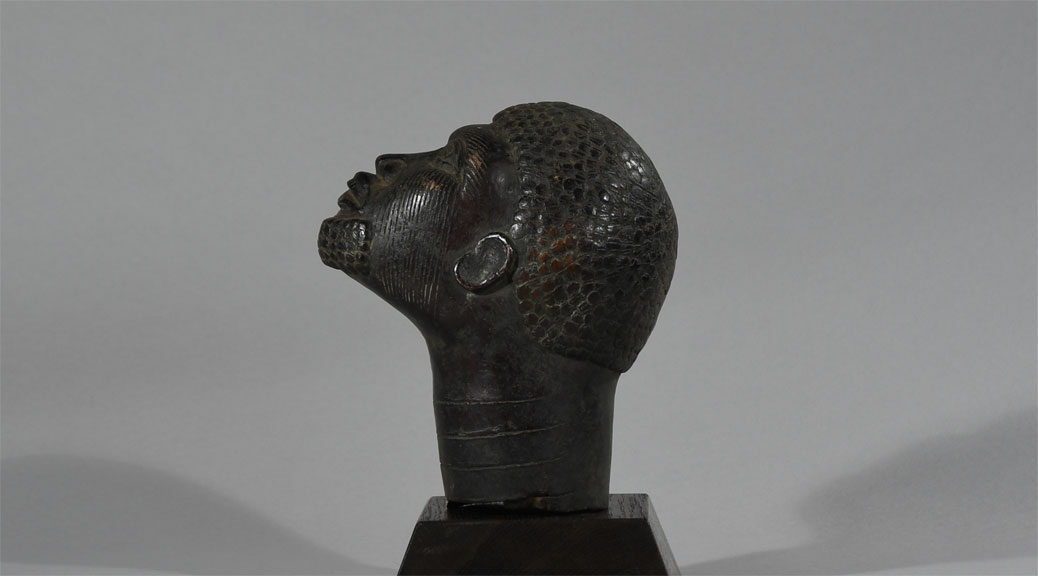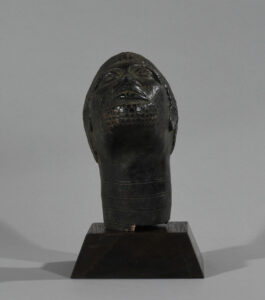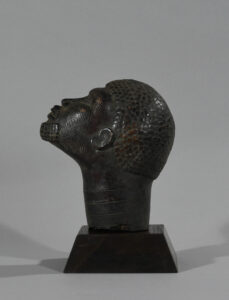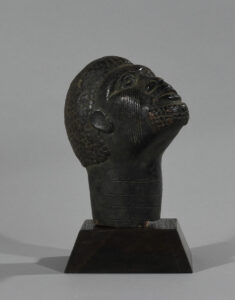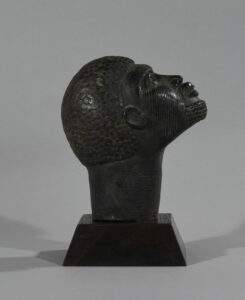ANK 0517-11
Ife Bronze Head of a Royal Person, Yoruba, Nigeria.
This beautiful and very rare, proportionate small but powerful Ife bronze head with an advanced, bearded chin and a solemn expression imagines a prince of the Ife kingdom. Which portrait filled its place in the row among the ‘royal portraits of the royal palace’.
These little heads are considered the most expensive as they have belonged to the royal palace’s own collection and exhibited along with the other members of the royal family.
The art of bronze casting was introduced around the year 1280. The kingdom of Ife (not to be confused with the later kingdom of Benin which lies, 256 miles or 412 miles to the east) reached together an artistic splendor in the 15th and 16th centuries. For a long time, the Ife and Benin bronze sculptures were the only historical evidence dating back several hundred years to the West African past, and both the level of technical achievement achieved in bronze casting as well as the monumental strength of the represented figures were the subject of great admiration.
This small, unusual and stunningly beautiful little bronze head of a young male person with cheek beard originates from the small West African kingdom of Ife which originated in the 13th century deep in the West African rainforests and belongs to Yoruba which is still the largest people in Nigeria (not to be confused with the second kingdom of Benin which lies, 256 miles or 412 miles to the east). This head which clearly illustrates a prince belong among other things because of the size of the most valuable figures that it has been going to exhibit inside the Royal Palace among the other royal family members.
Ife sculptures counts among some of the earliest naturalistic expressions of people in the world, which was also significantly ahead of the European Renaissance and even today is among mankind’s greatest artistic achievements and comes from a crucial time in the development of West African artistic traditions and technological innovation .
The casting is extremely high (Ife metal works are the finest in the ancient world; their sophistication – casting is only a few millimeters thick – was not until the 19th century seen in the West). This head was manufactured using the relatively crude method for casting perdue (lost wax), where a single, unique object created from a disposable form. It is unique because most other cultures are not able to make it particularly thin in shape, and this in order to capture fine, delicate surface detail. Early European explorers were so amazed at the fineness of these pieces, they refused to believe that African peoples had made them, in spite of the “classic” African traits in all cases is depicted. A similar head was observed on an altar in Ife’s royal palace and is believed to represent Obalufon II, the first king of Ife, who is said to have introduced the art of metal casting to his people.
This is a flawless piece of old African art of museum quality and one of the finest Ife pieces we have seen.
Age: late 19th to early 20th century.
Provenance: From the heirs of a private collector in Belgium. Where the collector got the head from is unknown.
Condition: The head is in perfect condition and appears in a dark patinated bronze.
Dimensions: H: 20, W: 10, D: 18 cm – weight 1,75 kg.
Literature:
Suzanne Preston Blier; “Art and Risk in Ancient Yoruba: Ife History, Politics, and Identity c.1300” Cambridge University Press, 2015.
John Mack (ed); “Africa, Arts and Cultures”, London, 2005
Editha Platte; “Bronze Head from Ife”, British Museum Press, 2010 –
